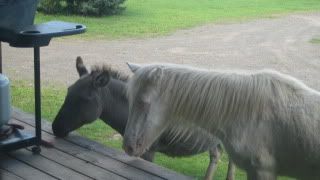Post by Lipizzan on Jul 18, 2014 9:08:07 GMT
The number of donkeys is gradually falling in Dalmatia, even though these domestic animals have always been of great help and service to man on Dalmatian islands, on the coastline and in the continental part of Dalmatia. They were used to carry firewood, different tools used in agriculture and other loads. Sometimes they were used also for riding. Races of donkeys are still being regularly held in this region.
The image of donkey often appears on the postcards, but this popular, lovely and smart animal, often called "tovar" in Dalmatia, represents the main turoust attraction in some parts of Dalmatian coast and on some islands. The Dalmatian donkey has been introduced into southern Croatia a long time ago and is still being raised. The first mentioning of donkey dates from 1214 from the statute of the island and city of Korčula. It was also mentioned in the statute of the old republic of Dubrovnik in 1272. In the continental part of Croatia they were raised in Lepoglava, a former Paulist monastery. They were also present in the Samobor mountains, where they were brought by from Senj by soldiers called "Uskoci".
Zoologists often describe the Dalmatian donkey having strong skeleton, firm bones, long neck, perceiving eyes, long ears, small but strong hoof, adapted to the limestone surface. In the region of Dalmatia, the ground being usually covered in limestone and not very accessible, the food and work force scarce, donkeys were very appreciated and especially used for carrying firewood through inaccessible areas.
Today donkey is almost treatened by extinction in Dalamatia. Its preservance in certain regions depends on his econimic function today, which differs a lot from its historical function. Nowadays it is seen almost exclusivly as a tourist attraction.
.jpg)
The image of donkey often appears on the postcards, but this popular, lovely and smart animal, often called "tovar" in Dalmatia, represents the main turoust attraction in some parts of Dalmatian coast and on some islands. The Dalmatian donkey has been introduced into southern Croatia a long time ago and is still being raised. The first mentioning of donkey dates from 1214 from the statute of the island and city of Korčula. It was also mentioned in the statute of the old republic of Dubrovnik in 1272. In the continental part of Croatia they were raised in Lepoglava, a former Paulist monastery. They were also present in the Samobor mountains, where they were brought by from Senj by soldiers called "Uskoci".
Zoologists often describe the Dalmatian donkey having strong skeleton, firm bones, long neck, perceiving eyes, long ears, small but strong hoof, adapted to the limestone surface. In the region of Dalmatia, the ground being usually covered in limestone and not very accessible, the food and work force scarce, donkeys were very appreciated and especially used for carrying firewood through inaccessible areas.
Today donkey is almost treatened by extinction in Dalamatia. Its preservance in certain regions depends on his econimic function today, which differs a lot from its historical function. Nowadays it is seen almost exclusivly as a tourist attraction.
.jpg)

 and goat herds from coyotes. I'll have to dig out some pics of my friends donks.
and goat herds from coyotes. I'll have to dig out some pics of my friends donks.






 , that is what I always say.
, that is what I always say. 